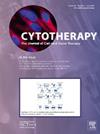A NOVEL ENGINEERED SKIN HEALS FULL THICKNESS BURN WOUNDS: A CASE REPORT
IF 3.7
3区 医学
Q2 BIOTECHNOLOGY & APPLIED MICROBIOLOGY
引用次数: 0
Abstract
Background & Aim
Timely wound closure in massive burns remains an unmet clinical need. Engineered skin substitutes can provide an alternative treatment to split skin grafting. However, since the development of Cultured Epithelial Autograft (Green's method), almost 50 years ago, limited cell and tissue therapies for burns have been introduced to clinics. The aim of this study was to show, as a proof of concept, that engineered skin grafts can substitute native skin grafts to close large burn wounds permanently.
Methodology
Here we describe engineering a dermal/epidermal composite skin graft in the treatment of a child suffering from burns > 60% total body surface area. A 5cm2 biopsy was collected from the child. Dermal and epidermal stem and progenitor cells were isolated and expanded according to good manufacturing practice (GMP) guidelines. A hydrogel, combined with autologous fibroblasts, was prepared in-house to act as a niche for the stem and progenitor interfollicular stem and progenitors in vitro and in vivo. Over 500 cm2 engineered skin was produced, clear of endotoxin, mycoplasma, bacteria and yeast pathogens. The engineered skin was grafted on a full thickness wound on right arm and right foot, temporised with NovoSorb ® Biodegradable Temporising Matrix (BTM). Grafts were analysed histologically. Cosmetic and scar outcome were measured over 12 months.
Results
Engineered skin graft take was estimated as 95% on day 14 post grafting without any need for native skin grafting. Histological analysis of the grafts, 2 weeks and 6 weeks post grafting, confirmed persistence of a complete and continuous, although slightly hyperproliferative, epidermis. The survival of the stem and progenitor keratinocytes in engineered skin was confirmed by immunofluorescence using Keratin 5, and Integrin beta 1 specific antibodies. Grafts were fully vascularised. Engineered graft scar quality, measured by POSAS, has remained superior to the gold standard native skin grafting at 6- and 12-months post grafting.
Conclusion
This study is a proof of concept for the application of this novel engineered skin as a definitive treatment option in paediatric burn injuries. This technology will reduce the need for traditional skin grafting in children with limited donor skin.
一种新型工程皮肤愈合全层烧伤创面:一例报告
背景,目的大面积烧伤创面及时闭合的临床需求尚未得到满足。工程皮肤替代物可以为裂皮移植提供另一种治疗方法。然而,自从近50年前培养上皮自体移植物(Green’s method)的发展以来,有限的细胞和组织治疗烧伤已被引入临床。本研究的目的是证明,作为概念的证明,工程皮肤移植物可以代替天然皮肤移植物永久关闭大面积烧伤创面。方法:在此,我们描述了一种真皮/表皮复合皮肤移植在治疗儿童烧伤中的工程应用。60%的体表面积。从患儿身上取5平方米活检。根据良好生产规范(GMP)分离和扩增真皮和表皮干细胞和祖细胞。水凝胶与自体成纤维细胞结合,在体外和体内作为干细胞和祖细胞的生态位。生产了超过500平方厘米的工程皮肤,清除了内毒素,支原体,细菌和酵母菌病原体。工程皮肤被移植到右臂和右脚的全层伤口上,用NovoSorb®可生物降解的临时基质(BTM)进行临时处理。对移植物进行组织学分析。在12个月内测量了美容和疤痕的结果。结果术后第14天,工程皮肤移植植皮率为95%,无需人工植皮。移植后2周和6周的组织学分析证实了表皮的完整和连续,尽管有轻微的增生。利用角蛋白5和整合素β 1特异性抗体,免疫荧光法证实了工程皮肤中干细胞和祖细胞的存活。移植物血管充足。POSAS测量的工程移植疤痕质量在移植后6个月和12个月仍然优于金标准的天然皮肤移植。结论:这项研究证明了这种新型工程皮肤作为儿科烧伤的最终治疗选择的概念。这项技术将减少对供体皮肤有限的儿童进行传统皮肤移植的需求。
本文章由计算机程序翻译,如有差异,请以英文原文为准。
求助全文
约1分钟内获得全文
求助全文
来源期刊

Cytotherapy
医学-生物工程与应用微生物
CiteScore
6.30
自引率
4.40%
发文量
683
审稿时长
49 days
期刊介绍:
The journal brings readers the latest developments in the fast moving field of cellular therapy in man. This includes cell therapy for cancer, immune disorders, inherited diseases, tissue repair and regenerative medicine. The journal covers the science, translational development and treatment with variety of cell types including hematopoietic stem cells, immune cells (dendritic cells, NK, cells, T cells, antigen presenting cells) mesenchymal stromal cells, adipose cells, nerve, muscle, vascular and endothelial cells, and induced pluripotential stem cells. We also welcome manuscripts on subcellular derivatives such as exosomes. A specific focus is on translational research that brings cell therapy to the clinic. Cytotherapy publishes original papers, reviews, position papers editorials, commentaries and letters to the editor. We welcome "Protocols in Cytotherapy" bringing standard operating procedure for production specific cell types for clinical use within the reach of the readership.
 求助内容:
求助内容: 应助结果提醒方式:
应助结果提醒方式:


